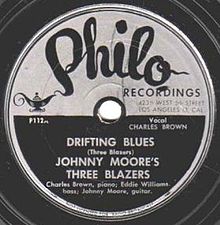- Driftin' Blues
-
"Driftin' Blues" 
Single by Johnny Moore's Three Blazers B-side "Groovy" Released December 1945 Format 10" 78 rpm record Recorded Los Angeles
September 14, 1945Genre Blues Length 3:12 Label Philo (Cat. No. 112) Writer(s) Charles Brown, Johnny Moore, Eddie Williams Johnny Moore's Three Blazers singles chronology "Baby Don't You Cry"/ "Blazer's Blues"
(1945)"Driftin' Blues"
(1945)"You Are My First Love"/ "Race Track Blues"
(1946)"Driftin' Blues" or "Drifting Blues" is a blues standard done in the West Coast blues style.[1] Written and first recorded by Johnny Moore's Three Blazers,[2]the song became one of the biggest blues hits of the 1940s.[3] Over the years, it has been interpreted and recorded by numerous artists. The original "Driftin' Blues" has been acknowledged by the Blues Hall of Fame and the Rock and Roll Hall of Fame.
Contents
Original song
Johnny Moore's Three Blazers recorded "Driftin' Blues" in 1945. The group, sometimes known as a "club blues"[4] combo, was composed of Charles Brown (vocals and piano), Johnny Moore (guitar), Eddie Williams (bass), and Johnny Otis (drums). The song was developed during their frequent Los Angeles club appearances and is credited to Brown, Moore, and Williams.[3] The song is a slow-tempo twelve-bar blues, that features Brown's vocal and piano. Brown commented that it "was the first song that I wrote down and tried to sing".[3] Their performances of the song were well received and led to a recording contract with Philo (soon to become Aladdin) Records.[3] "Driftin' Blues" became a hit, spending twenty-three weeks in the Billboard R&B chart.[5] The song reached #2 and "emerged [as] one of the top selling black records in 1945 and 1946".[3]
Other versions
Due to the song's popularity, other artists were soon performing and recording "Driftin' Blues". Some followed the original, while others interpreted it differently. As early as 1946, a young Ray Charles was performing it regularly. As he commented: "Charles Brown was a powerful influence on me in the early part of my career, especially when I was struggling down in Florida. I made many a dollar doing my imitation of his 'Drifting Blues'. That was a hell of a number".[6] In 1950, Lightnin' Hopkins recorded a different arrangement of the song, accompanied only by his amplified guitar (John Lee Hooker made a similar adaptation in 1961). Billy Eckstine recorded it in 1959 for the album Basie/Eckstine Incorporated. Chuck Berry recorded his interpretation for his 1960 album Rockin' at the Hops.
"Driftin' Blues" entered the charts again in 1968 when Bobby "Blue" Bland recorded it. His version reached #23 during a stay of eleven weeks in the Billboard R&B chart.[7] Bland's version also made an appearance in the Billboard Pop chart at #96. At the Monterey Pop Festival in 1967, the Paul Butterfield Blues Band (complete with horn section) performed an eight-minute version of "Driftin' Blues". Another live version of the song, featuring an extended guitar solo, was recorded by Albert King at the Fillmore Auditorium in 1968. In 1969, Charles Brown recorded an updated version of "Driftin' Blues" that "came off as new, thanks to Earl Hooker's inspired slide work".[8] Eric Clapton recorded several versions of the song, including a group arrangement for his live 1975 album E. C. Was Here and a solo acoustic piece (as "Driftin'") for his 1994 album From the Cradle.
Recognition
Many more versions of "Driftin' Blues" have been recorded by a variety of artists, including several by Charles Brown. The song was inducted in to Blues Hall of Fame in 1989 in the "Classics of Blues Recordings" category[9] and was included in the Rock and Roll Hall of Fame list of "500 Songs that Shaped Rock and Roll".[10]
Notes
- ^ Herzhaft 1992, p. 445.
- ^ Some lyrics appear in Bumble Bee Slim's 1935 "Walking and Drifting Blues".
- ^ a b c d e Hannusch 1992, p. 3-4.
- ^ Cogdell Dje Dje 1998, p. 225.
- ^ Whitburn 1988, p. 299.
- ^ Charles 2003
- ^ Whitburn 1988, p. 26.
- ^ Danchin 2001, p. 298.
- ^ "1989 Blues Hall of Fame Inductees". The Blues Foundation. http://www.blues.org/halloffame/inductees.php#ref=halloffame_inductees. Retrieved 2009-08-24.
- ^ "500 Songs that Shaped Rock and Roll". Rock and Roll Hall of Fame. 2004. Archived from the original on June 8, 2007. http://web.archive.org/web/20070608105851/http://www.rockhall.com/exhibithighlights/500-songs-by-name-df/. Retrieved March 4, 2011.
References
- Herzhaft, Gerard (1992). Encyclopedia of the Blues. University of Arkansas Press. ISBN 1-55728-252-8.
- Hannusch, Jeff (1992). Driftin' Blues: The Best of Charles Brown (liner notes). Aladdin CDP-7-97989-2.
- Cogdell Dje Dje, Jacqueline; Meadows, Eddie S. (1998). California Soul: Music of African Americans in the West. University of California Press. ISBN 9780520206281.
- Whitburn, Joel (1988). Top R&B Singles 1942-1988. Records Research, Inc. ISBN 0-89820-068-7.
- Charles, Ray; Ritz, David (2003). Brother Ray: Ray Charles' Own Story. Da Capo Press. ISBN 9780306813351.
- Danchin, Sebastian (2001). Earl Hooker: Blues Master. University of Mississippi Press. ISBN 9781578063079.
Categories:- 1945 songs
- Charles Brown songs
- 1968 singles
- Ray Charles songs
- John Lee Hooker songs
- Albert King songs
- Eric Clapton songs
- Blues songs
Wikimedia Foundation. 2010.
